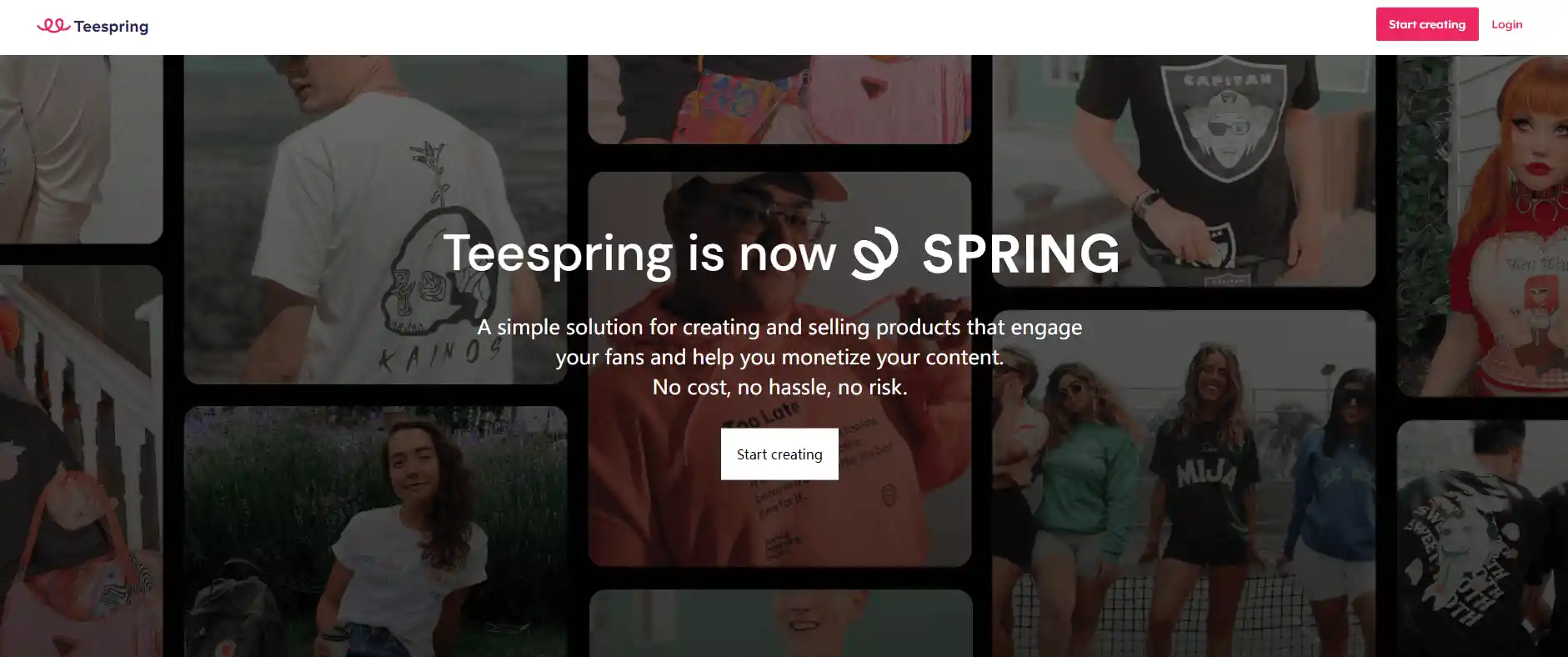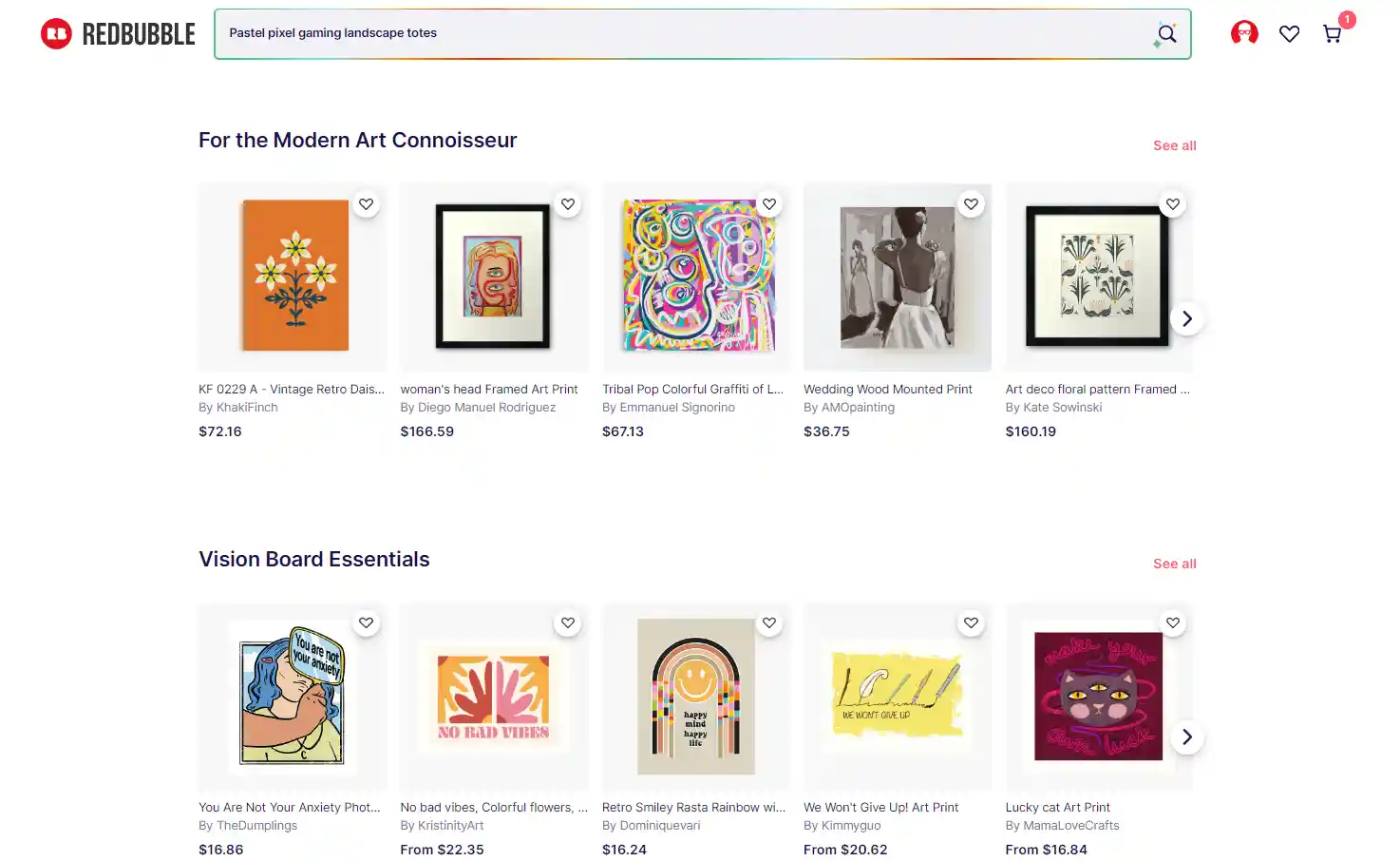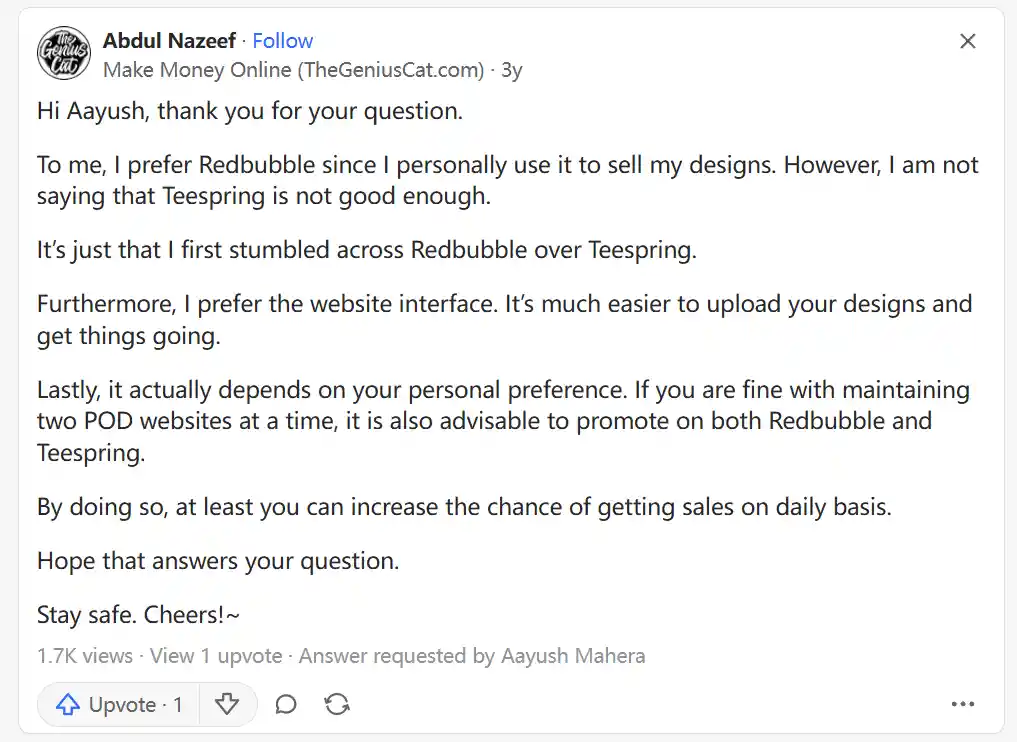
Hey there, creative entrepreneurs and aspiring moguls! If you've ever wondered whether Redbubble or Teespring is the better choice for your print-on-demand business, you're in the right place. Choosing the perfect platform can feel a bit like picking the right outfit for an important event—both need to fit just right and make you look good!
Redbubble and Teespring each bring their own unique flair to the table, and understanding their strengths can help you make a savvy decision.
In this blog, we'll dive into the nitty-gritty of both platforms, breaking down what makes each one tick. So grab a cup of coffee, get comfy, and let's embark on this journey to find out which platform will help your business shine brightest!
Learn About Redbubble and Teespring
Redbubble
Redbubble is a dynamic marketplace that has been fostering creativity since its inception in 2006. It provides a platform for artists to showcase their work and reach a global audience.
One of the key advantages of Redbubble is its user-friendly interface. Artists can easily manage their online stores, track sales, and engage with customers. The platform also offers extensive customization options, enabling creators to set their own profit margins.
Redbubble's strong community aspect provides valuable resources and support for artists looking to grow their presence and improve their craft.
By partnering with reputable suppliers worldwide, Redbubble ensures that products meet high standards and are delivered promptly to customers around the globe. This global reach not only broadens the potential customer base but also enhances the visibility of artists' work.
Teespring

Teespring, now rebranded as Spring, started in 2011 with a focus on helping users create and sell custom apparel. Over time, it has expanded its product range to include items similar to those offered by Redbubble, such as mugs, posters, and phone cases. What sets Teespring apart is its unique campaign-based selling model. Creators can launch campaigns for their designs, set sales goals, and promote these campaigns within a specific timeframe to drive urgency and boost sales.
The platform provides powerful marketing tools that allow users to leverage social media and email marketing effectively. Teespring's integration with major social media platforms makes it easier for creators to reach their target audience and increase sales. Additionally, Teespring offers analytics tools that help users track the performance of their campaigns in real-time.
In terms of quality control, Teespring maintains high standards by working with trusted manufacturers. This ensures that products are not only well-made but also delivered efficiently to customers worldwide.
Detailed Comparison of Redbubble and Teespring
Product Variety
Redbubble offers an extensive range of products, from clothing and accessories to home decor and stationery. This diversity allows your creativity to flourish across multiple formats, giving you the freedom to experiment with different designs on various items. Imagine your art not just on a t-shirt but also on a throw pillow or a notebook—it's like having a gallery at your fingertips.
Teespring, while initially focused on apparel, has expanded its offerings to include lifestyle products such as mugs, phone cases, and posters. Although its range isn't as vast as Redbubble's, it continues to grow, especially in custom clothing. If you're looking to start with apparel and gradually branch out, Teespring might be your ideal choice.
Selling Approach
Redbubble operates like a continuous art exhibition where your designs are always available for purchase. This approach suits those who prefer a passive income stream without constant oversight. You upload your work, and the platform handles the rest, making it easy for artists who want their creations available 24/7.

Teespring functions more like a pop-up shop. You create campaigns with specific sales goals and timeframes, generating excitement and urgency around your products. You can also set the store logo and banner according to your preferences and brand style to attract your audience to stay in your store.

Fulfillment Process
Both platforms manage production and shipping, ensuring high-quality standards are maintained throughout the process. Redbubble partners with global manufacturers for efficient worldwide delivery, offering peace of mind that your creations are well-handled no matter where they end up.
Teespring ensures quality through trusted suppliers, emphasizing efficiency once campaign goals are achieved. This means you can focus on creating while they handle logistics—perfect for those who prefer campaign-based bursts of activity rather than continuous availability.
Profit Potential & Pricing
With Redbubble, you set your profit margins by adjusting the markup on each product. This flexibility allows you to experiment with pricing strategies as your business evolves, providing a steady stream of income from multiple sources.
Teespring's campaign model can lead to higher profits during successful runs due to its focus on targeted marketing efforts and limited-time offerings. Teespring allows you to enter a more accurate US price and EU price, and it will also show you the profit percentage you can get from this price.
Marketing and Integration
Redbubble relies heavily on organic reach within its platform. It's much like planting seeds that grow over time through community support and visibility. While it doesn't offer extensive external marketing tools, the internal search engine helps new customers discover your work.

Teespring provides powerful tools for external marketing, including integrations with social media platforms like YouTube and TikTok. This capability is akin to having a megaphone that broadcasts your campaigns far and wide, allowing you to tap into new audiences effectively. If you're savvy with social media marketing, Teespring offers the tools to amplify your brand.

Community Engagement
Redbubble fosters a vibrant artist community where collaboration and inspiration flourish. Being part of this network is like joining an artistic collective that encourages mutual growth and feedback. The platform's forums and artist challenges provide opportunities to connect with other creators.
Teespring focuses on empowering creators to build their brand through direct audience interaction. This approach is ideal for those who love crafting personalized experiences for their followers, using tools like email marketing and custom storefronts to engage directly with their customer base.
Read More:
The Pros and Cons of Redbubble
Pros:
Wide Product Range: Redbubble is like a vast art gallery where your designs can be showcased on everything from t-shirts to shower curtains. This extensive variety allows you to diversify your offerings and attract different customer segments.
Passive Income Stream: Once you upload your designs, they're always available for purchase. This means you can earn money while you sleep—ideal for those who prefer a hands-off approach.
Artist Community: Redbubble fosters a supportive community of artists. It's like being part of an artistic collective where you can find inspiration, feedback, and collaboration opportunities.
Global Reach: With manufacturing partners worldwide, Redbubble ensures that your products can reach customers across the globe efficiently.
Cons:
Lower Profit Margins: Due to Redbubble's pricing structure, profit margins can be slimmer compared to other platforms. It's like running a marathon where the finish line feels just a bit further away.
Limited Marketing Tools: Redbubble relies heavily on organic reach within its platform. While this is great for passive discovery, it lacks robust external marketing tools, making it harder to push your products beyond their marketplace.
Less Control Over Branding: The platform's design doesn't allow much customization of your storefront, limiting how you present your brand.
Read More:
The Pros and Cons of Teespring
Pros:
High-Profit Potential: Teespring's campaign model can lead to higher profits during successful runs due to focused marketing efforts and limited-time offers. It's like striking gold after a well-planned expedition.
Powerful Marketing Tools: Teespring integrates seamlessly with social media platforms and e-commerce sites, giving you a megaphone to amplify your campaigns and reach new audiences effectively.
Custom Storefronts: You have more control over how your store looks, allowing you to create a branded experience that resonates with your audience.
Flexible Selling Approach: The campaign-based model creates urgency and excitement around your products, which can drive higher engagement and sales.
Cons:
Time-Intensive Management: Running campaigns requires constant attention and active promotion. It's like hosting regular events—you need to keep the momentum going.
Limited Product Range (Initially): While Teespring has expanded its product offerings, it started with a focus on apparel, so its range isn't as extensive as Redbubble's.
Fulfillment Delays: Since production begins after a campaign ends, customers might experience longer wait times for their orders compared to continuous fulfillment models.

Redbubble Vs Teespring: Which Is Best for Your Business?
So, which platform is best for your business? If you're seeking simplicity and access to an existing customer base, Redbubble might be your go-to choice. It's perfect for artists and designers who prefer focusing on creativity rather than marketing.
If you're prepared to engage in active marketing and want higher profit potential through customizable campaigns, Teespring could be the better option. It's ideal for those ready to leverage their own audience or build one from scratch.
The best choice depends on your specific business goals and how much effort you're willing to invest in marketing versus creating. Both platforms offer unique strengths—it's all about finding the one that aligns with your vision.
Real Reviews of Redbubble Vs Teespring on Quora and Redbubble
When it comes to choosing between Redbubble and Teespring, real user reviews provide invaluable insights. Let's explore what users are saying on platforms like Reddit and Quora.
Insights from Reddit
Xxv_faith offers a balanced perspective on the print-on-demand (POD) business. They highlight that while POD can be enjoyable and low-stress since you're your own boss, it's not necessarily an "easy way" to make money. Many new sellers struggle to get their first sale, but xxv_faith encourages perseverance, noting that worthwhile endeavors take time and effort.

Regarding platform preference, xxv_faith leans towards Redbubble. They appreciate Redbubble's built-in marketplace, which makes it easier for potential buyers to discover your work. Additionally, Redbubble's email marketing efforts help remind customers about items they've shown interest in, potentially boosting sales. The higher website traffic on Redbubble is another plus.
On the other hand, xxv_faith points out that Teespring might be better suited for influencers or those with a large following due to its focus on bulk orders. While Teespring offers higher artist margins, it lacks a marketplace, meaning you need to drive traffic to your store independently.
Opinions from Quora
Abdul Nazeef shares his personal preference for Redbubble, citing ease of use and a more intuitive website interface as key reasons. He finds it simpler to upload designs and get started on Redbubble compared to Teespring. However, he also acknowledges that both platforms have their merits and suggests that using both simultaneously could increase daily sales opportunities.

Another Quora user, Ayon SG, highlights a unique feature of Teespring: the ability to list products directly on YouTube channels. This integration is particularly beneficial for merchandising, especially for those who already have a significant online presence.

What Platforms Can Replace Redbubble and Tespring?
Zazzle
Zazzle is a haven for creative minds who want to offer highly customizable products. It's like an art studio where imagination knows no bounds. From custom invitations to unique gifts, Zazzle allows designers to create a wide array of personalized items.
While it may not integrate as seamlessly with external e-commerce platforms as some other options, Zazzle's built-in marketplace attracts millions of visitors each month. This can be a significant advantage if you're looking to tap into an existing customer base without heavy marketing efforts.

Society6
If your focus is on high-quality art prints and home decor, Society6 could be your go-to platform. It's akin to displaying your artwork in a trendy gallery where art lovers flock. Society6 specializes in turning artists' designs into premium products like wall art, furniture, and lifestyle accessories.
While it operates more like a marketplace than an integrated e-commerce solution, Society6 provides exposure to a dedicated audience passionate about unique artistic creations. This can be particularly beneficial for artists looking to build their brand within a niche market.

Expert Tips
Choosing between Redbubble and Teespring depends on your needs and goals. Redbubble excels with its user-friendly interface, built-in marketplace, and supportive email marketing, ideal for attracting organic traffic. Conversely, Teespring offers higher profit margins and unique integrations like YouTube product listings, making it perfect for influencers and those with an established audience.
Both platforms have their unique strengths and can serve different types of sellers effectively. Whether you prioritize ease of discovery or maximizing profits, understanding these nuances will help you make an informed decision.
Embrace the platform that aligns best with your vision, invest time and effort, and watch your POD business flourish. Remember, success in the print-on-demand world is about finding the right fit and staying committed to your creative journey.










 Global Shipping
Global Shipping




























